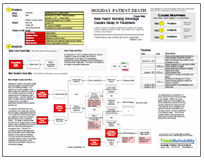The successful activation of emergency plans allowed 8 hospitals in the Boston area to treat 144 trauma patients injured in the bombings that occurred April 15, 2013 near the finish line of the Boston Marathon. Even with that heavy burden, these hospitals ensured the continued safety of patients and staff during a very unsure time, as well as assisting the police and Federal Bureau of Investigation (FBI) with the ongoing investigation.
While details on the bombings themselves are still being determined and disseminated, it’s apparent that emergency planning and preparedness processes within the area Boston hospitals were successful in allowing an ‘unprecedented’ response. We can view the response to the bombings by the area hospitals in what we like to call a root cause “success” analysis. After all, lessons can be learned not only from what didn’t go well, but also what did. Hospitals around the country can learn from the response by the Boston area hospitals to this trauma.
When Massachusetts General asked hospital staff from Israel, who unfortunately see this kind of trauma on a far more regular basis, to give emergency response training they likely did not suspect their hospital to be the site of a horrific mass trauma like that experienced in Boston. The hospital’s experience with war-style trauma was certainly extremely helpful in dealing with the aftermath of this kind of trauma, rarely seen outside of war zones. As Dr. Ron Walls, the chairman of the Department of Emergency Medicine at Brigham and Women’s Hospital stated, “For many, many people in emergency medicine who are practicing domestically and not in the military, these are once-in-a-lifetime events.”
For once-in-a-lifetime events, facilities have to hope that the training and education they’ve provided to their staff, and the processes that they’ve developed for dealing with emergencies, can stand up to the tragedy. In this case, these Boston hospitals (once they have time to take a breath, which may not be for a while), should give themselves a pat on the back for their amazing handling of a tragic event. Hospitals elsewhere should take note and ensure that their emergency procedures will allow the same sort of successful response.
A pat on the back should also go out to the staff in the medical tent at the finish line, whose quick actions and extensive equipment allowed on-scene stabilization and quick transfer of the severely injured to the area hospitals. Lastly, the many spectators who kept their cool and assisted on scene should also be commended.
To view the Outline and Cause Map, please click “Download PDF” above. Or click here to learn more about the emergency procedures at Massachusetts General.

 According to a
According to a 





